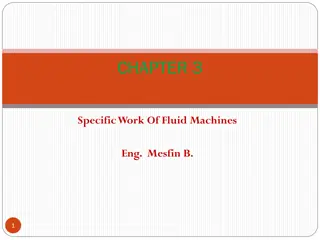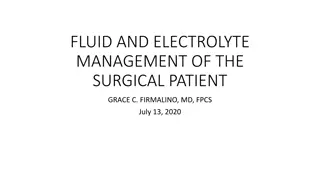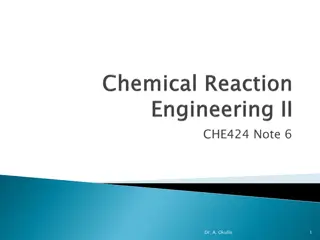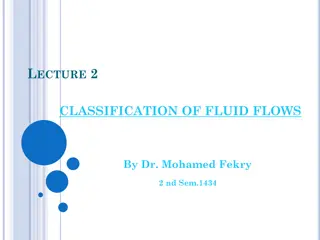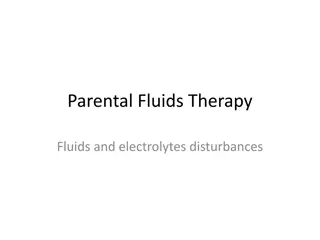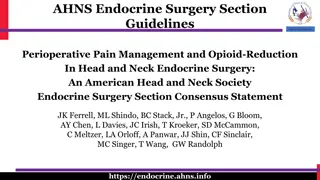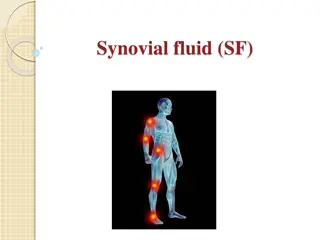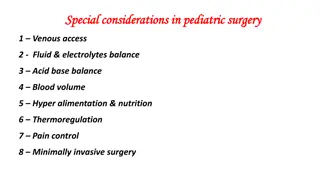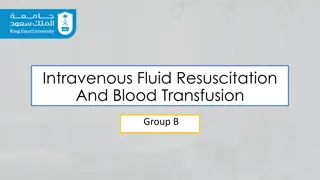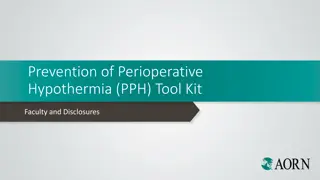Perioperative Fluid Therapy: Key Concepts and Considerations
Understanding perioperative fluid therapy is crucial for maintaining normovolemia, achieving hemodynamic stability, and preventing complications. Factors such as total body water variation, fluid resuscitation goals, desirable outcomes, and fluid and electrolyte regulation play a critical role in ensuring successful perioperative patient management. Preoperative evaluation of fluid status, assessing orthostatic hypotension, and calculating perioperative fluid requirements are essential steps for optimal patient care.
Download Presentation

Please find below an Image/Link to download the presentation.
The content on the website is provided AS IS for your information and personal use only. It may not be sold, licensed, or shared on other websites without obtaining consent from the author.If you encounter any issues during the download, it is possible that the publisher has removed the file from their server.
You are allowed to download the files provided on this website for personal or commercial use, subject to the condition that they are used lawfully. All files are the property of their respective owners.
The content on the website is provided AS IS for your information and personal use only. It may not be sold, licensed, or shared on other websites without obtaining consent from the author.
E N D
Presentation Transcript
PERIOPERATIVE FLUID THERAPY Dr. Sayeed Nawaz Consultant anesthesit Department of Anesthesiology KKUH. King Saud University
Total Body Water (TBW) Varies with age, gender 55% body weight in males 45% body weight in females 80% body weight in infants Less in obese: fat contains little water
Final Goals of Fluid resuscitation - Achievement of normovolemia& hemodynamic stability - Correction of major acid-base disturbances - Compensation of internal fluid fluxes - Improvement of microvascular blood flow - Prevention of cascade system activation - Normalization of O2 delivery - Prevention of reperfusion cellular injury - Achievement of adequate urine output
Desirable outcome of fluid resuscitation - No peripheral edema - No ARDS
Fluid and Electrolyte Regulation Volume Regulation - Antidiuretic Hormone - Renin/angiotensin/aldosterone system - Baroreceptors in carotid arteries and aorta - Stretch receptors in atrium and juxtaglomerular apparatus - Cortisol
Preoperative Evaluation of Fluid Status Factors to Assess: - History of intake and output - blood pressure: supine and standing - heart rate - skin - Urinary output - mental status
Orthostatic Hypotension Systolic blood pressure decrease of greater than 20mmHg from supine to standing Indicates fluid deficit of 6-8% body weight - Heart rate should increase as a compensatory measure - If no increase in heart rate, may indicate autonomic dysfunction or antihypertensive drug therapy
Perioperative Fluid Requirements The following factors must be taken into account: 1- Maintenance fluid requirements 2- NPO deficits 3- Third space and invisible losses 4- Special additional losses: diarrhea, bowel preparation, tracheostomy, 5- Replacement of blood loss
1- Maintenance Fluid Requirements Insensible losses such as evaporation of water from respiratory tract, sweat, feces, urinary excretion. Occurs continually. Adults: approximately 1.5 ml/kg/hr 4-2-1 Rule - 4 ml/kg/hour for the first 10 kg of body weight - 2 ml/kg/hour for the second 10 kg body weight - 1 ml/kg/hour subsequent kg body weight
2- NPO and other deficits NPO deficit = number of NPO hours x maintenance fluid requirement Add about 1 liter, if bowel preparation is done Measurable fluid losses, e.g. NG suctioning, vomiting, colostomy output, surgical drains.
3- Third Space & invisible Losses Isotonic transfer of ECF from functional body fluid compartments to non-functional compartments. Depends on location and duration of surgical procedure, amount of tissue trauma, ambient temperature, room ventilation.
Replacing invisible Losses Superficial surgical trauma: 1-2 ml/kg/hr Minimal Surgical Trauma: 3-4 ml/kg/hr - head and neck, hernia, knee surgery Moderate Surgical Trauma: 5-6 ml/kg/hr - hysterectomy, chest surgery Severe surgical trauma: 8-10 ml/kg/hr (or more) - AAA repair, nehprectomy
4- Blood Loss Replace 3 ccof crystalloid solution per cc of blood loss (crystalloid solutions leave the intravascular space) When using blood products or colloids replace blood loss volume per volume
5- Other additional losses Ongoing fluid losses from other sites: - gastric drainage - ostomy output - diarrhea Replace volume per volume with crystalloid solutions
Example 62 y/o male, 80 kg, for hemicolectomy NPO after 10 PM, surgery at 8 AM, Received bowel preparation 3 hours long procedure with blood loss of 500 ml What is his estimated intraoperative fluid requirement?
Fluid requirement of this patient Fluid deficit (NPO): 1.5 ml/kg/hr x 10 hrs = 1200 ml + 1000 ml for bowel preparation = 2200 ml is total deficit: (Replace 1/2 first hour, 1/4 2nd hour, 1/4 3rd hour). Maintenance: 1.5 ml/kg/hr x 3hrs = 360mls invisible Losses: 6 ml/kg/hour x 3 hours =1440 ml Blood Loss: 500ml x 3 = 1500ml Total = 2200+360+1440+1500=5500mls
Intravenous Fluids: Conventional Crystalloids Colloids Hypertonic Solutions Blood/blood products and blood substitutes
Crystalloids Combination of water and electrolytes - Balanced salt solution: electrolyte composition and osmolality similar to plasma; example: lactated Ringer - Hypotonic salt solution: electrolyte composition lower than that of plasma; example: D5W. - Hypertonic salt solution: 2.7% NaCl.
Crystalloids in trauma Advantages: -Balanced electrolyte solution -Easy to administer -No risk of adverse reactions -No disturbance of hemostasis -Promote diuresis -Inexpensive
Crystalloids Disadvantages: -Poor plasma volume support -Large quantities needed -Risk of Hypothermia -Reduced plasma oncotic pressure -Risk of edema
Tonicity of the fluids Cells can be exposed to three types of solutions in the body Isotonic : solute concentration is the same out and inside the cell Hypotonic : moresolutes inside the cells than outside Hypertonic : more solutes outside the cell than inside
Hypertonic Solutions Fluids containing sodium concentrations greater than normal saline. Available in 1.8%, 2.7%, 3%, 5%, 7.5%, 10% solutions. Hyperosmolarity creates a gradient that draws water out of cells; therefore, cellular dehydration is a potential problem.
Hypertonic saline Advantages: -Small volume for resuscitation. -Osmotic effect -Direct vasodilator effect -Increase MAP, CO -Increase renal, mesenteric, splanchnic, coronary blood flow.
Hypertonic saline Disadvantages: increase hemorrhage from open vessels. Hypernatremia Hyperchloremia. Metabolic acidosis.
Crystalloids Lactated Ringer's Composition: Na 130, cl 109, K 4, ca 3, Lactate 28, Osmolarity 273 mosmol/l -Sydney Ringer 1880 -Hartmann added Lactate=LR -Minor advantage over NaCl Disadvantages: -Not to be used for dilution of blood (Ca citrate)
Crystalloids Dextrose 5% Composition: 50 gm /liter, provides 170 kcal /liter Disadvantages: -enhance CO2 production -enhance lactate production
Composition Fluid Osmo- lality 253 Na Cl K 0 0 0 D5W 308 154 154 0 0.9NS 4.0 273 130 109 LR 5.0 294 140 98 Plasma-lyte 310 154 154 0 Hespan 308 145 145 0 0 5% Albumin 1027 513 513 3%Saline
Colloids Fluids containing molecules sufficiently large enough to prevent transfer across capillary membranes. Solutions stay in the space into which they are infused. Examples: hetastarch (Hespan), albumin, dextran.
Colloids Advantages: -Prolonged plasma volume support -Moderate volume needed -minimal risk of tissue edema -enhances microvascular flow
Colloids Disadvantages: Risk of volume overload Adverse effect on haemostasis Anaphylactic reaction Expensive
Crystalloids versus colloids Charactor Crystalloids Colloids In the vein Poor Good Hemody. Stability Transient Prolong Infusion volume Large Moderate Plasma COP Reduced Maintain Tissue edema Obvious Insignificant Anaphylaxis Non-exist low-mod Cost Inexpensive Expensive
Assessment of fluid status 1. Urine Output: at least 1.0 ml/kg/hour 2. Vital Signs: Blood pressure and heart rate 3. Physical Assessment: texture of skin and mucous membranes; thirst in an awake patient 4. Invasive monitoring; CVP may be used as a guide 5. Laboratory tests: periodic monitoring of hemoglobin and hematocrit
Summary Fluid therapy is critically important during the perioperative period. The most important goal is to maintain hemodynamic stability and protect vital organs from hypoperfusion (heart, liver, brain, kidneys). All sources of fluid losses must be accounted for. Good fluid management goes a long way toward preventing problems.
Transfusion Therapy - 60% of transfusions occur perioperatively. - responsibility of transfusing perioperatively is with the anesthesiologist.
Blood Groups Antigen on Plasma Antibodies Anti-B Anti-A None Anti-A Anti-B Incidence White African- 40% 11 4 45 42 Blood Group erythrocyte A B AB O Rh A B AB None Rh Americans 27% 20 4 49 17
Type and Screen Donated blood that has been tested for ABO/Rh antigens and screened for common antibodies (not mixed with recipient blood). - Used when usage of blood is unlikely, but needs to be available (hysterectomy). - Chance of hemolytic reaction: 1:10,000.
Cross Match Major: - Donor s erythrocytes incubated with recipients plasma Minor: - Donor s plasma incubated with recipients erythrocytes Agglutination: - Occurs if either is incompatible Type Specific: - Only ABO-Rh determined;
Screening before transfusion Various bacterial and viral screening Hepatitis B Hepatitis C HIV 1 HIV 2 Syphilis
Blood Components Red Blood cells All WBCs are removed Red cells are stored in a bag containing CPD-A ( Citrate Phosphate Dextrose Adenine) Shelf life is 35 days, store always at 2-6 degrees Use with in 30 min, and finish before 4 hours. Never store blood in domestic fridge
Blood components platelets For platelet deficiency and hemorrhagic disorders Shelf life 5-6 days Stored at 20 degrees, Do not refrigerate
Blood components FFP and cryoprecipitate Plasma frozen to -30 degrees with in 4 hours It contains proteins, enzymes, hormones and electrolyte Supplied at 4 degrees Should be consumed as soon as possible (12 Hrs) Bacterial proliferation Cryoprecipitate is specially rich in factor VIII
Transfusion Complications Acute Transfusion Reactions (ATR s) Chronic Transfusion Reactions Transfusion related infections
Acute Transfusion Reactions Hemolytic Reactions (AHTR) Febrile Reactions Allergic Reactions TRALI Coagulopathy with Massive transfusions Bacteremia
Complications of Blood Therapy (cont.) Hemolytic: - Wrong blood type administered (oops). - Activation of complement system leads to intravascular hemolysis, spontaneous hemorrhage.
Complications of Blood Therapy (cont.) Hypotension Chills, rigors, fever dyspnea, skin flushing, substernal pain , Back/abdominal pain Oliguria Dark urine, Pallor Signs are easily masked by general anesthesia. - Free Hgb in plasma or urine - Acute renal failure - Disseminated Intravascular Coagulation (DIC)
Complications (cont.) Transmission of Viral Diseases: - Hepatitis C; 1:30,000 per unit - Hepatitis B; 1:200,000 per unit - HIV; 1:450,000-1:600,000 per unit - Parasitic and bacterial transmission very low
What to do? If an AHTR occurs STOP TRANSFUSION ABC s Maintain IV access and run IVF (NS or LR) Monitor and maintain BP/pulse Give diuretic Obtain blood and urine for transfusion reaction workup Send remaining blood back to Blood Bank








